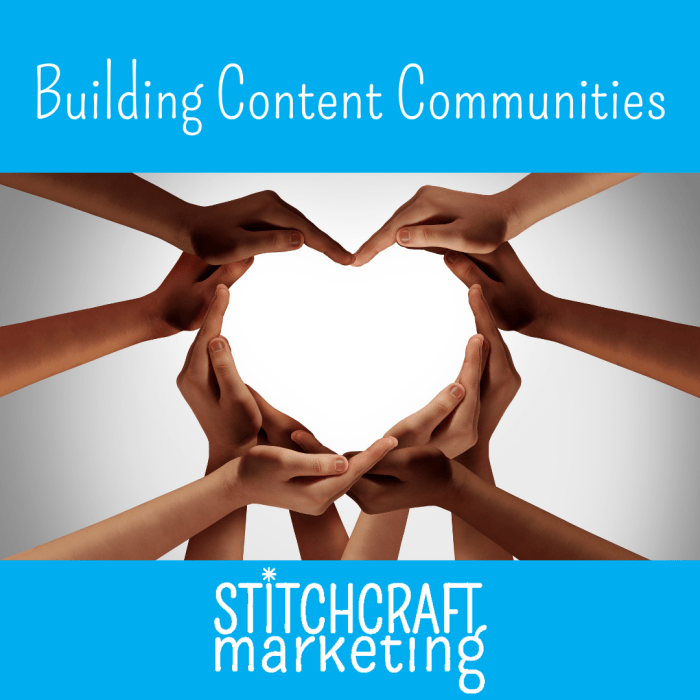Building a Content Community dives into the key strategies and tools needed to create a thriving online community. From boosting brand loyalty to driving organic traffic, this topic is all about cultivating a strong online presence.
Learn about engaging with your audience, creating shareable content, and leveraging social media to build your community from the ground up.
Importance of Building a Content Community
Building a content community is like having your own squad in the online world. It’s crucial for online success because it helps you connect with your audience on a deeper level, creating a loyal following that keeps coming back for more.
Enhancing Brand Loyalty
When you have a strong content community, it’s like having a group of friends who always have your back. They trust your brand, engage with your content, and are more likely to stick around for the long haul. This kind of loyalty is priceless in the digital landscape where competition is fierce.
Driving Organic Traffic
Your content community is like a magnet that attracts organic traffic to your website. When people resonate with your content and feel like they’re part of a community, they are more likely to share your content with others. This word-of-mouth marketing can bring in a steady stream of organic traffic, boosting your online presence and visibility.
Strategies for Building a Content Community

Building a content community requires deliberate strategies to engage with the audience and foster a sense of belonging. Here are some effective methods to consider:
Creating Valuable and Shareable Content
Creating valuable and shareable content is key to building a content community. By providing content that resonates with your audience, you can establish your brand as a trusted source of information. Here are some tips to create content that drives engagement:
- Understand your audience: Take the time to research and understand the interests, preferences, and pain points of your target audience. Tailor your content to address their needs and provide value.
- Consistent quality: Ensure that your content is of high quality and provides valuable insights or entertainment. Consistency in quality will help build trust with your audience.
- Encourage interaction: Prompt your audience to engage with your content through comments, likes, shares, and polls. Respond to their comments and messages to foster a sense of community.
- Utilize multimedia: Incorporate visuals, videos, infographics, and other multimedia elements to make your content more engaging and shareable.
Remember, the goal is to create content that not only informs but also inspires your audience to take action and share with others.
Leveraging Social Media Platforms
Social media platforms are powerful tools for building and growing a content community. Here are some tips on how to leverage social media effectively:
- Choose the right platforms: Identify the social media platforms where your target audience is most active and focus your efforts on building a presence there.
- Consistent posting: Develop a content calendar and schedule regular posts to keep your audience engaged and informed. Consistency is key to maintaining visibility.
- Engage with your audience: Respond to comments, messages, and mentions promptly. Show your audience that you value their input and are listening to their feedback.
- Cross-promotion: Collaborate with influencers, partners, or other brands to reach a wider audience and increase your content’s visibility.
Tools and Platforms for Content Community Building

When it comes to building a strong content community, having the right tools and utilizing the most effective platforms can make all the difference. Let’s dive into some key tools and popular platforms that can help you in managing and monitoring community interactions.
Key Tools for Managing and Monitoring Community Interactions
Having the right tools to manage and monitor community interactions is crucial for the success of your content community. Here are some key tools that can help:
- Social Media Management Platforms: Tools like Hootsuite, Buffer, and Sprout Social can help you schedule posts, monitor engagement, and analyze performance across different social media channels.
- Community Management Platforms: Platforms like Discord, Slack, and Reddit offer features that allow you to create and manage online communities effectively.
- Analytics Tools: Tools like Google Analytics, SEMrush, and Moz can provide valuable insights into the performance of your content and help you make data-driven decisions.
Popular Platforms for Content Community Building
Content communities thrive on various platforms where users can engage, share, and interact with each other. Here are some popular platforms and how to effectively utilize them:
- Facebook Groups: Create a Facebook Group around your niche or topic to foster discussions, share content, and build a loyal community of followers.
- LinkedIn Groups: Utilize LinkedIn Groups to connect with professionals in your industry, share valuable content, and establish thought leadership.
- Discord Servers: Discord provides a platform for real-time communication, collaboration, and community building through text, voice, and video channels.
Comparison of Different Community-Building Platforms, Building a Content Community
Each community-building platform has its unique features and advantages. Let’s compare a few platforms to help you choose the best fit for your content community:
| Platform | Unique Features |
|---|---|
| Facebook Groups | Allows for targeted discussions, event scheduling, and personalized notifications for members. |
| LinkedIn Groups | Focuses on professional networking, B2B interactions, and sharing industry-specific content. |
| Discord Servers | Offers customizable roles, moderation tools, and integrated voice chat for community engagement. |
Measuring Success of a Content Community: Building A Content Community
Building a successful content community is not just about creating engaging content, but also about measuring its impact and effectiveness. By tracking specific metrics, analyzing user behavior, and gathering feedback, content creators can gain valuable insights to improve their community and better cater to the needs of their audience.
Metrics to Track Growth and Engagement
- Number of active members: Monitor the growth of your community by tracking the number of active members over time.
- Engagement rate: Measure how engaged your community is by analyzing likes, comments, shares, and other interactions on your content.
- Retention rate: Keep track of how many members continue to engage with your community over an extended period.
- Conversion rate: Measure how effectively your content is converting viewers into active community members or customers.
Analytics for Understanding Member Behavior
Analytics tools can provide valuable insights into the behavior and preferences of your community members. By analyzing data such as demographics, browsing patterns, and content interactions, content creators can tailor their content to better suit the needs and interests of their audience. This data-driven approach can help in creating more targeted and engaging content that resonates with community members.
Importance of Feedback for Community Improvement
Feedback is a crucial tool for understanding the needs and preferences of your audience. By actively seeking feedback from community members, content creators can identify areas for improvement and make necessary adjustments to enhance the overall community experience.
Feedback can come in various forms, including surveys, polls, comments, and direct messages. By listening to the feedback provided by community members, content creators can gain valuable insights that can help in refining their content strategy and fostering a stronger sense of community engagement.
